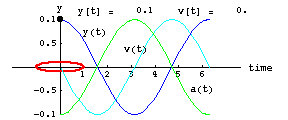
Suppose I could place an electron of charge ( q= - e ) on the axis of a charged ring of radius R and charge (+ q ). I further suppose that I could "let go" of this electron at various locations on the axis of the ring. I assume that the electron remains on the axis of the ring during its entire motion. I will drop the electron with zero initial speed at the following locations.
1) Near the center of the ring .
2) Further away from the center
Guess the Answer
Here is how we would guess the answer.First a possitvely charged ring will create an electric field along the axis of the ring. Due to the symmetry , we only have the y-component of the electric field pointing along the +y-axis. We now place an electron of charge q= - e on the axis of the ring. We assume the electron is constrained to move along the y-axis of the ring similar to the up and down motion of a " bead along a string". The electron on the axis sees itself being immersed into an external electric field created by the positively charged ring. At this time, the electron of negative charge feels an attractive electrostatic force toward the possitvely charged ring which is assumed to be fixed on the circumference of the ring,( electrostatic.) The only force that contributes to the motion of the electron is the y-component of the force, opposite to the direction of the electric field. That is
( the y-component of) F = - e E ( the y-component of the electric field)
After the release, the electron stay on the axis and rushes downward toward the center of the ring. At the center of the ring the electric field is zero. Can you guess why this is true ? Due to the electron's inertia , the electron "overshoots" the center to the other side of the ring where the force on the electron is in the upward direction. This upward force causes the electron to move toward the the center of the ring, going upward toward its original position where it was dropped. For this ideal model, the up and down motion of the electron would continue indefinitely.This simple reasoning would lead us to believe that dropping an electron into a ring of charge near its center should have the same physical behavior as an undamped simple harmonic motion in a mass spring system.The animation shown below is a representation of an "electron oscillation" near the center of the ring.

(End of answer to Q1)
Websites related to this problem
![]() Expand
your Knowledge (Taylor series, gradient , "Mathematica"
solutions )
Expand
your Knowledge (Taylor series, gradient , "Mathematica"
solutions )